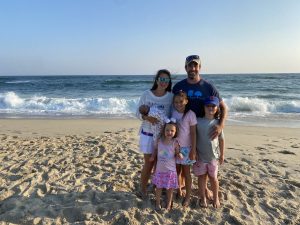Through the Eyes of Love: Just James!
Caitlin and Greg Smith eagerly looked forward to the birth of their fourth child, who would complete their busy family of two girls and a boy. Caitlin’s pregnancy was unremarkable, and the family excitedly welcomed baby James in June 2023. But when he was about two months old, the couple noticed that James wasn’t visually tracking as they had expected. “His eyes were closed much more than our other children, and I remember thinking that was odd,” Caitlin said. “He also wouldn’t lock eyes with us or look directly at objects or our faces.” Worried, the Smiths took James to their pediatrician, who wasn’t overly concerned given his age but suggested seeing a pediatric ophthalmologist.
A Diagnosis
Unfortunately, the ophthalmology exam revealed that something was wrong. “The doctor noticed pigmentation in his macula and mentioned it could be a number of things but recommended that James be seen by a retinal specialist at Boston Children’s Hospital,” said Caitlin. “The doctor did a clinical exam and, based on seeing degeneration in the retina, diagnosed James with Leber congenital amaurosis (LCA). It was a terrible shock. We knew nothing about inherited retinal diseases or LCA.”
The next step was genetic testing, which revealed James had LCA9, caused by a mutation in the NMNAT1 gene. Greg and Caitlin were also tested, and their results verified that James’ LCA was inherited and not the result of a random mutation. “Just knowing what we were dealing with was a big milestone,” Greg said. “But we needed to know where to go from here.”
After learning that many children with LCA9 are born with no light perception or severe vision impairment, they were encouraged that James appears to be on the better end of the spectrum. “We know he has light perception, can see colors, and has some functional vision. Sometimes, he appears to track people or large objects, but it’s hard to know if it’s because he’s hearing or seeing something,” Caitlin said.
Finding Support, Getting Educated
Immediately after the diagnosis, the Smiths dedicated themselves to researching and understanding all they could about LCA and visual impairments. “As a parent, you always want what is best for your child, and to think about and create what would be best for him, we needed to educate ourselves,” said Caitlin. As they searched LCA online, Hope in Focus popped up. “The day we got the
clinical diagnosis, or maybe a day later, we found Hope in Focus,” Greg said.

James with his toys.
Several days later, Greg spoke with Courtney Coates, Hope in Focus Director of Outreach and Development, who provided him with family and research connections and a high-level review of the current treatments and technologies relevant to LCA9. “It’s hard to put into words how impactful it was to get this diagnosis and to be able to go online and get connected to a community of people that could hear our story and help,” he said. “Having Hope in Focus was incredible for us as we began this journey. It makes such a difference knowing you’re not alone. We are forever grateful to Laura, Courtney, and the rest of the Hope in Focus team.”
Courtney also connected the Smiths with another Hope in Focus family whose son had LCA9, which Caitlin said provided an “awesome jumping-off point for connecting to other families with the same mutation.” They’ve also found other LCA9 families in the US and abroad through social media.
Through recommendations from Hope in Focus and via their research, the Smiths began reaching out and networking with people researching and developing potential treatments. “Getting more involved with the research community has been very helpful, and as a family, we are very focused on helping to advance a treatment for James and others with LCA9,” Greg explained.
In James’ case, early-stage preclinical work has been conducted on a potential gene therapy treatment for the NMNAT1 mutation, with promising results in mouse models. “With these rare diseases, taking a traditional path to treatment development is very challenging given the economics involved,” said Greg.
Living Life
His parents describe James as outgoing, adventurous, fearless, and a ball of fun who is always smiling and laughing. “His siblings are totally in love with him,” said Caitlin. Now, James is just another sibling rather than a sibling with a vision impairment.”
Greg said that he and Caitlin dealt with James’ diagnosis in different ways. It was more challenging for him to accept the vision impairment, and his mind went to all of the things that his son might not be able to do that his siblings could do. “I think Caitlin did a much better job internalizing all of that,” he said.
Caitlin said that she turned her grief into action by focusing on the next steps, such as identifying and arranging for therapies. “It felt like a blessing that our life is so busy. There wasn’t time to sit around and be depressed or in shock—instead, I focused on James’ immediate needs and how we could best support him and give him an amazing life, just like our other children. I didn’t want him to be treated any differently from other kids. We will not allow his vision to define him, but we will make sure he has every opportunity every other child has,” she said.

The Smith family.
Daily life at the Smiths is essentially divide and conquer. Greg works at an investment firm and has taken the lead in researching the disease and potential therapies in his spare time. Caitlin is a stay-at-home mom who is incredibly busy with the three older children’s sports schedules and James’ physical, occupational, vision, and speech therapies. They have gotten involved with the NAPA Center in Boston, which offers specialized coaching and therapies for children with disabilities, and they attend a weekly baby group at the Perkins School for the Blind. They feel lucky and thankful for access to excellent resources and support nearby. “It’s been incredible to see how much James has grown and all the milestones he has accomplished. In certain areas, he is more advanced at this age than our other three were,” Caitlin said.
James currently sees three different doctors, including a local eye specialist who used to work at Boston Children’s Hospital. He also goes to Boston Children’s Hospital once a quarter, and there is a yearly trip to the Children’s Hospital of Philadelphia.
Regarding advice for other LCA families, Greg and Caitlin said it may seem overwhelming initially, but everything will be okay. “I struggled with the diagnosis for a while. But now we’re at a place where we feel like James is not our child with LCA. He is just James!”
